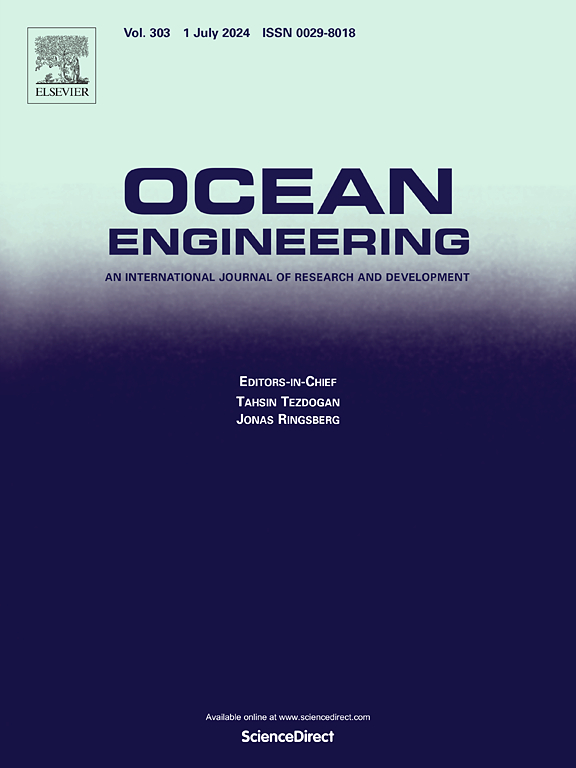Investigation into heading stability of turret-moored vessels in regular waves
IF 5.5
2区 工程技术
Q1 ENGINEERING, CIVIL
引用次数: 0
Abstract
In practical marine engineering, single-point mooring (SPM) vessels under heading regular wave excitation manifest sustained and large-amplitude slow yaw motions. To clarify the essential mechanisms, this work employs the nonlinear dynamics method to investigate the bifurcation characteristics and stability of the system. Firstly, the phenomenon of yaw instability was observed in experiments. Then, the surge-sway-yaw horizontal motion equations were established, linear stability analysis was conducted, and the stability criterion was obtained. Comparison with experimental and numerical results demonstrates great agreement. Subsequently, critical parameters, including turret position and pitch damping, are selected to analyze the bifurcation characteristics and evaluate the yaw stability region. The results show that wave frequency, turret position, pitch damping, and load condition affect equilibrium heading angle and yaw stability pronouncedly. In contrast, wave height and mooring stiffness demonstrate negligible impact on equilibria and yaw static stability. It is concluded that yaw instability under regular waves manifests as a transition process where the SPM system shifts from its zero equilibrium point to a non-zero equilibrium state, indicating a loss of static stability. The qualitative analysis of system parameters presented in this paper could offer practical guidance for the preliminary design stage of SPM vessels, particularly in optimizing turret positioning, load condition, and metocean conditions.
规则波条件下炮塔系泊船舶航向稳定性研究
在实际的海洋工程中,单点系泊船在航向规则波激励下表现出持续的、大幅度的慢偏航运动。为了阐明其基本机理,本文采用非线性动力学方法研究了系统的分岔特性和稳定性。首先,在实验中观察到偏航不稳定现象。然后,建立了横摆横摆水平运动方程,进行了线性稳定性分析,得到了稳定性判据。与实验和数值计算结果比较,结果吻合较好。随后,选取炮塔位置和俯仰阻尼等关键参数,分析其分岔特性,并对偏航稳定区域进行评估。结果表明,波浪频率、转塔位置、俯仰阻尼和载荷条件对平衡航向角和偏航稳定性有显著影响。相比之下,波高和系泊刚度对平衡和偏航静稳定性的影响可以忽略不计。结果表明,规则波作用下的偏航失稳表现为系统从零平衡点向非零平衡状态的过渡过程,表明系统失去了静稳定性。本文所提出的系统参数定性分析可为SPM船的初步设计阶段提供实用指导,特别是在优化转塔定位、载荷工况和海洋环境等方面。
本文章由计算机程序翻译,如有差异,请以英文原文为准。
求助全文
约1分钟内获得全文
求助全文
来源期刊

Ocean Engineering
工程技术-工程:大洋
CiteScore
7.30
自引率
34.00%
发文量
2379
审稿时长
8.1 months
期刊介绍:
Ocean Engineering provides a medium for the publication of original research and development work in the field of ocean engineering. Ocean Engineering seeks papers in the following topics.
 求助内容:
求助内容: 应助结果提醒方式:
应助结果提醒方式:


